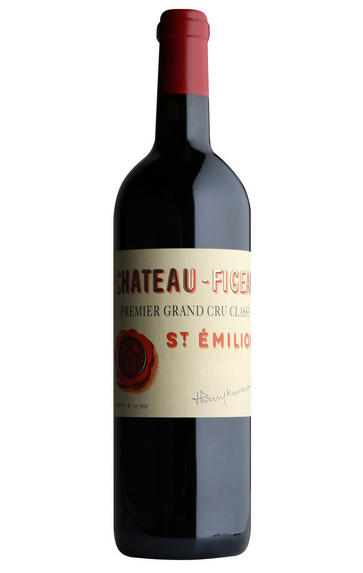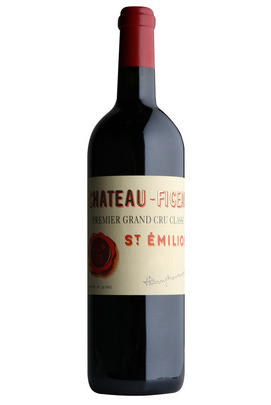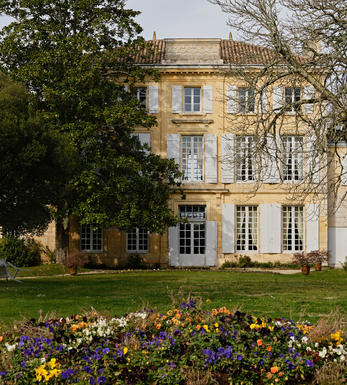
2018 Château Figeac, St Emilion, Bordeaux

Critics reviews
The 2018 Figeac continues to not put a toe, let alone a foot, wrong under head winemaker Frédéric Faye. The bottle is closed initially, and in fact it was only the following morning that it began to unfold and reveal its true character. Quintessential Figeac on the nose, it offers blackberry, briar, pencil shavings courtesy of the Cabernet Sauvignon, and touch of terracotta. Beautifully defined, as we have come to expect these days; I might well confuse it for a Pomerol. The palate is medium-bodied and has soaked up the 100% new oak. Lithe tannins render this more approachable than the Figeacs of yesteryear, yet it maintains the same DNA. Elegant and refined, it gently fans out with pure, slightly tertiary black fruit and traces of clove and bay leaf. To quote my conclusion from barrel, it is still "cool, calm and collected" on the finish. Divine.
Drink 2024 - 2055
Neal Martin, Vinous (January 2021)
The 2018 Figeac is a regal, aristocratic Saint-Émilion. Vertical in feel, Figeac possesses stunning energy and vibrancy right out of the gate. Dark cherry, plum, mocha, licorice, rose petal and spice all open with a bit of coaxing. Figeac is a bit restrained today, but it won't be an issue in another few years' time. Figeac is not an obvious wine, but it is superb.
Drink 2028 - 2058
Antonio Galloni, Vinous (March 2021)
I loved this en primeur, and it absolutely lives up to billing now that it is in bottle. It has put on a little weight through the mid palate, closed down further as you would expect at this point, but retains all the depth and texture of the black fruits, burnished with coffee beans, liquorice and crushed stone. It has much in common with the 2016 but there is a juicier, more succulent quality to the finish than the 2016 had at this stage, and I wouldn't be surprised if it turns out to be even better. Harvest ran from 17 September to 12 October, giving a yield of 39hl/ha (with 70% organic farming, 30% bio-control). 65% of the crop went into the grand vin. 3.7pH.
Drink 2026 - 2045
Jane Anson, Decanter
Back to a more traditional blend after last year's frost impact, Figeac has done a wonderful job of harnessing the opulence of the vintage while maintaining freshness. This is extremely focussed and precise, with a silky texture and inky depths, developing complexity as the flavours unfurl. These are big tannins but they steal up on you, doing that subtle creep that's such a marker of the vintage. Powerful, utterly gorgeous and clearly a wine that will age well, this is equal to the estate's excellent 2016. Harvest ran from 17 September to 12 October, giving a 39hl/ha yield (with 70% organic farming, 30% bio-control). 65% of the crop went into the grand vin. 3.7pH.
Drink 2027 - 2042
98/100 - Jane Anson, Decanter (April 2019)
37% Merlot, 30% Cabernet Franc, 33% Cabernet Sauvignon. Full bottle 1,342 g.
Tasted blind. Slightly dull crimson with a fading rim. Light tea-leaf aroma. Sweet and ripe and satisfying. Thick, dense. Lots going on here! Marked ripe tannins. Definitely a youthful bordeaux but with some sweetness – Figeac?
Drink 2026 - 2045
Jancis Robinson, JancisRobinson.com (July 2023)
The 2018 Figeac is composed of 37% Merlot, 33% Cabernet Sauvignon and 30% Cabernet Franc, with a 3.7 pH and 14% alcohol. Deep garnet-purple in color, it soars out of the glass with opening notes of freshly crushed red and black cherries, mulberries and ripe, juicy plums, followed by hints of violets, damp soil, cedar chest, crushed rocks and pencil shavings. The medium-bodied, elegantly styled palate features bags of freshness and exquisitely ripe, beautifully poised tannins to support the bright, energetic black and red fruit layers, finishing on a lingering fragrant earth note. This is absolutely recognizable as being cut from the same cloth as old-school Figeac, but all the recent vineyard and winemaking improvements have unveiled the beautifully ripe, intense, nuanced potential here. Bravo to managing director/winemaker Frédéric Faye and his team! Although there is a lot to love about this wine right now, give it 5-6 years for the oak to fully integrate and the underlying perfume suggestions to emerge, then enjoy over the next 20-25 years or more.
Drink 2026 - 2051
Lisa Perrotti-Brown, Wine Advocate (April 2021)
Great minty coolness and focus for this vintage! So much vitality and drive! I love the elegant dryness of this wine, which has only a hint of the opulence of this vintage. Very long and energetic finish with wonderful, herbal and mineral freshness. Excellent potential. Drinkable now, but best from 2025. Château Quintus vertical tasting. SP.
James Suckling, JamesSuckling.com (June 2022)
This still exudes the freshness and exuberance that the wine had during the primeur stage with its scents of blackcurrant, raspberry, and crushed strawberry along with a delicate floral touch. The new oak is perfectly integrated while imparting a subtle smoky note. The attack is surprisingly creamy, announcing a full-bodied texture wrapped around perfectly polished tannins allied with fine-judged acidity that together provide thrust leading to a finish that is intense yet light-footed and infused with freshness. This is a truly remarkable wine that will surely develop an even more velvety mouthfeel in years to come. Bravo.
Drink 2025 - 2050
Yohan Castaing, Decanter (September 2021)
Reminiscent of the 2016 with its incredible purity and elegance, the 2018 Château Figeac offers a terrific perfume of crème de cassis, redcurrants, dried earth, tobacco, lead pencil, spring flowers, and exotic spice-driven nuances. Playing in the medium to full-bodied end of the spectrum, it's flawlessly balanced, has silky, polished tannins, and a stunning sense of purity. It doesn't have the sexiness of the 2015, but it's very much in the style of the 2018 vintage with its pure, elegant, haut couture-like style. And it doesn't show a hint of its 100% new oak élevage. Give bottles 4-5 years of bottle age and enjoy over the following 20-30 years.
It's not the biggest or richest Saint- Emilion, yet the balance, finesse, and elegance are something to behold. I think it's going to check in behind the 2015 (and maybe the 2019) when all is said and done, but it's unquestionably one of the greatest Figeac in the past 20-30 years.
The blend is 38% Cabernet Sauvignon, 36% Merlot, and the balance Cabernet Franc, raised all in new oak. Another big “Bravo” to the talented director, Frédéric Faye!
Drink 2025 - 2050
Jeb Dunnuck, JebDunnuck.com (March 2021)
About this WINE

Château Figeac
Château Figeac is one of the leading St. Emilion estates and its wine, with its high Cabernet content, has often been described as the most Médoc-like in St-Emilion. The estate is located in the north-west of the appellation with its vineyards adjoining those of Cheval Blanc. Its 54 hectares of vineyards lie on a deep, Médoc-like gravel topsoil over a flinty, iron-rich subsoil. Figeac was promoted in 2022 to the level of Premier Grand Cru Classé A, the top tier of the St Emilion classification.

St Émilion
St Émilion is one of Bordeaux's largest producing appellations, producing more wine than Listrac, Moulis, St Estèphe, Pauillac, St Julien and Margaux put together. St Emilion has been producing wine for longer than the Médoc but its lack of accessibility to Bordeaux's port and market-restricted exports to mainland Europe meant the region initially did not enjoy the commercial success that funded the great châteaux of the Left Bank.
St Émilion itself is the prettiest of Bordeaux's wine towns, perched on top of the steep limestone slopes upon which many of the region's finest vineyards are situated. However, more than half of the appellation's vineyards lie on the plain between the town and the Dordogne River on sandy, alluvial soils with a sprinkling of gravel.
Further diversity is added by a small, complex gravel bed to the north-east of the region on the border with Pomerol. Atypically for St Émilion, this allows Cabernet Franc and, to a lesser extent, Cabernet Sauvignon to prosper and defines the personality of the great wines such as Ch. Cheval Blanc.
In the early 1990s there was an explosion of experimentation and evolution, leading to the rise of the garagistes, producers of deeply-concentrated wines made in very small quantities and offered at high prices. The appellation is also surrounded by four satellite appellations, Montagne, Lussac, Puisseguin and St. Georges, which enjoy a family similarity but not the complexity of the best wines.
St Émilion was first officially classified in 1954, and is the most meritocratic classification system in Bordeaux, as it is regularly amended. The most recent revision of the classification was in 2012

Cabernet Sauvignon Blend
Cabernet Sauvignon lends itself particularly well in blends with Merlot. This is actually the archetypal Bordeaux blend, though in different proportions in the sub-regions and sometimes topped up with Cabernet Franc, Malbec, and Petit Verdot.
In the Médoc and Graves the percentage of Cabernet Sauvignon in the blend can range from 95% (Mouton-Rothschild) to as low as 40%. It is particularly suited to the dry, warm, free- draining, gravel-rich soils and is responsible for the redolent cassis characteristics as well as the depth of colour, tannic structure and pronounced acidity of Médoc wines. However 100% Cabernet Sauvignon wines can be slightly hollow-tasting in the middle palate and Merlot with its generous, fleshy fruit flavours acts as a perfect foil by filling in this cavity.
In St-Emilion and Pomerol, the blends are Merlot dominated as Cabernet Sauvignon can struggle to ripen there - when it is included, it adds structure and body to the wine. Sassicaia is the most famous Bordeaux blend in Italy and has spawned many imitations, whereby the blend is now firmly established in the New World and particularly in California and Australia.


Buying options
Add to wishlist
Description
Blend: 37% Merlot, 33% Cabernet Sauvignon, 30% Cabernet Franc.
It’s an ebullient Figeac this year. The yield is down 20% because the Cabernet berries were so small, but that has given the wine concentration. There were no mildew or drought stress problems and there was only light extraction to preserve freshness and aromas. With notes of summer pudding and graphite, and amazing tannins, almost melting, this is a big Figeac of the modern era.
Drink 2028 - 2045
Berry Bros. & Rudd
wine at a glance
Delivery and quality guarantee